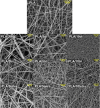Novel Aphid-Repellent Fiber Mats Based on Poly(lactic acid)-Containing Ionic Liquids
- PMID: 38343968
- PMCID: PMC10851260
- DOI: 10.1021/acsomega.3c06753
Novel Aphid-Repellent Fiber Mats Based on Poly(lactic acid)-Containing Ionic Liquids
Abstract
To protect crops as well as human and animal health, the development of novel repellents based on biopolymers is critical for a growing world population. Here, novel aphid-repellent electrospun mats containing epoxidized ionic liquids (ILs) covalently bonded to the carboxyl or hydroxyl groups of poly(lactic acid) (PLA) were designed to produce nonwoven mats. First, di-, tri-, and tetra-epoxidized imidazolium ILs were synthesized and incorporated in different weight fractions (3, 5, and 10 wt %) into the PLA solution. Then, the effect of ILs' microstructure, thermal properties, mechanical performance, and hydrophobic behavior were investigated. It was found that the incorporation of ILs resulted in a reduction of the fiber diameters while the mechanical properties of the mats, i.e., the three-dimensional fibrous porous structure, were maintained. Finally, the effect of these three ILs against the pea aphid Acyrthosiphon pisum (Harris) was evaluated for the first time, showing an attractive effect for the diepoxidized IL and a repellent effect for the tri- and tetra-epoxidized ILs. By exploiting the chemical nature of ILs, an environmentally friendly strategy can be developed to limit the need for chemical pesticides and petroleum-based polymers.
© 2024 The Authors. Published by American Chemical Society.
Conflict of interest statement
The authors declare no competing financial interest.
Figures









References
-
- Aphids as Crop Pests/Edited by Helmut F. van Emden and Richard Harrington; Van Emden H. F.; Harrington R., Eds.; CABI: Wallingford, UK; Cambridge, MA, 2007.
-
- Loxdale H. D.; Balog A.; Biron D. G. Aphids in Focus: Unravelling Their Complex Ecology and Evolution Using Genetic and Molecular Approaches. Biol. J. Linn. Soc. 2020, 129 (3), 507–531. 10.1093/biolinnean/blz194. - DOI
-
- Olson K. D.; Badibanga T. M.; DiFonzo C.; Olson K. D.; Badibanga T. M.; DiFonzo C.. Farmers’ Awareness and Use of IPM for Soybean Aphid Control: Report of Survey Results for the 2004, 2005, 2006, and 2007 Crop Years; 2008.
LinkOut - more resources
Full Text Sources
